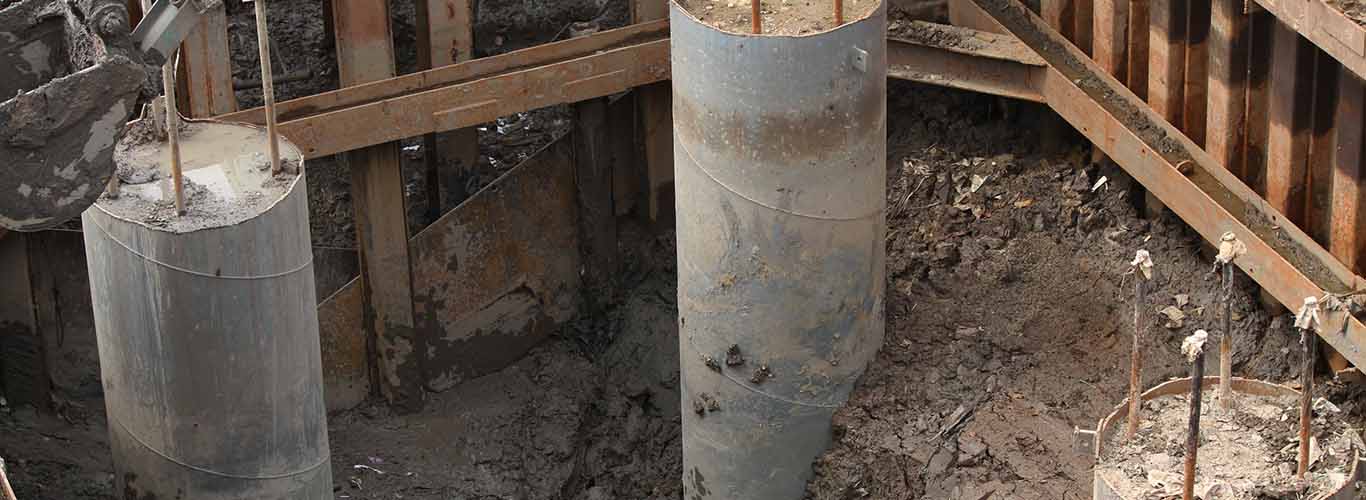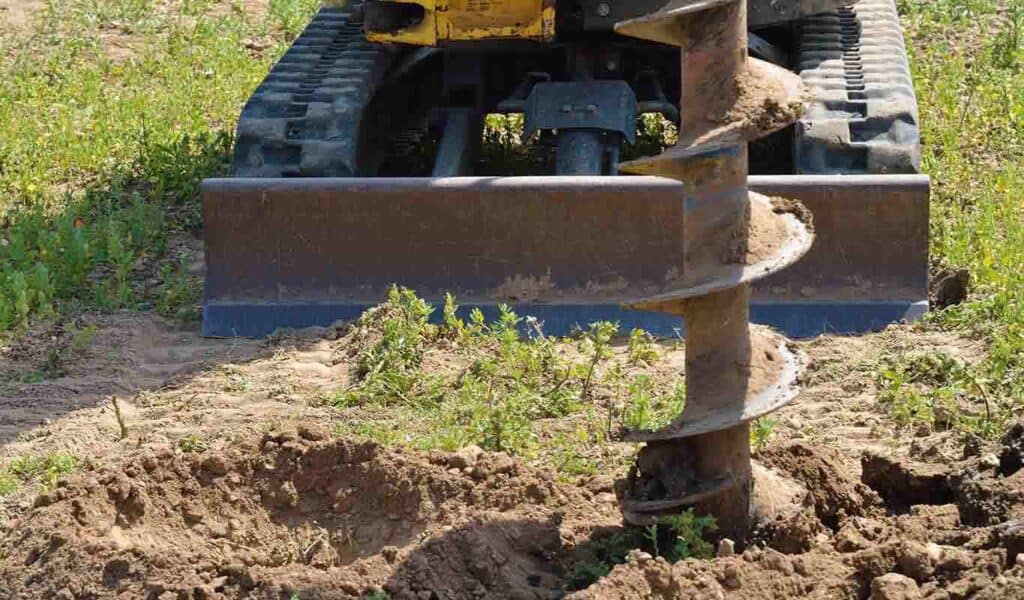Piled foundations, also known as deep foundations, are a type of foundation system used when the soil near the surface cannot support the weight of a building or structure.
Piled foundations are built with the help of long piles or columns. These are driven/drilled into the ground to reach more suitable soil strata. The piles transfer the weight of the building or structure to the deeper, more stable soil layers below the surface.
There are several types of piled foundations, including driven pile foundations, installed by driving the piles with the help of pile drivers into the ground, while bored pile foundations are created by drilling a hole into the ground and then filling it with concrete and a reinforcement cage.
Piled foundations are commonly used in areas with weak or unstable soil conditions, such as expansive clay soils, soft or compressible soils, or areas with a high water table. They are also highly suitable for constructing infrastructure that requires a high load-bearing value. Piled foundations can provide a more stable and secure foundation for buildings and structures, particularly in difficult soil conditions.

When Are Piled Foundations Needed?
Piled foundations are needed when the soil near the surface cannot support the weight of a building or structure. This can occur for several reasons, including:
- Weak or Unstable Soil Conditions: If the soil near the surface is weak or unstable, it may not be able to withstand the load of a building or structure. This can be due to factors such as clay soils, soft or compressible soils, or areas with a high water table.
- Heavy Loads: Buildings or structures with heavy loads, such as high-rise buildings, bridges, and industrial structures, may require piled foundations to distribute the weight of the load evenly and ensure the stability of the structure.
- Sloping or Uneven Ground: If the ground is sloping or uneven, piled foundations can create a level base for the building or structure.
- Site Access: In some cases, the site may be difficult to access, making it challenging to use shallow foundations. In these cases, piled foundations may be the most practical solution.
How Do Piled Foundations Work?
Piled foundations work by transferring the weight of a building or structure from the upper, weaker soil layers to deeper, more robust soil or rock layers. This is accomplished by using long, slender columns, or piles, that are driven or drilled deep into the soil to reach more stable strata such as soil or rock.
There are several types of piled foundations, but the two most common are driven pile foundations and bored pile foundations.
Driven pile foundations are constructed by driving piles into the construction site with the help of a pile driver. These pile drivers make use of either heavy weight or a hammer for driving the pile till it reaches a deeper soil stratum. The process continues till the prescribed number of piles have been driven into the ground. Once these piles have been driven, they are covered with pile caps, which enable the even distribution of the infrastructure’s weight across the piles.
In bored pile foundations, a hole is drilled into the ground to the required depth and then filled with concrete and a reinforcement cage. The reinforcement cage is typically made up of steel bars or mesh, which provides additional strength and support to the pile. The remaining process is the same as driven piles.
Replacement or Bored Piles
Replacement and bored piles are two types of piled foundations used in construction.
Replacement piles, also known as displacement piles, are typically used in soils that are firm to stiff and have low groundwater levels. The process involves driving a metal casing or tube into the ground and then filling it with concrete as the tube is extracted. Thie extraction creates a void in the soil, which is then filled by the concrete, forming a pile. Replacement piles can be installed quickly and efficiently and are particularly useful in areas where noise and vibration need to be minimised.
When the site soil is too soft or has a very low load-bearing value, bored piles are the preferred piling technique. Holes are drilled and filled with concrete with a steel reinforcement cage. Bored piles are typically wider than replacement piles and can be drilled to greater depths. Industrial structures, high-rise buildings, and other infrastructure with heavy loads are often supported by employing bored piles. The choice between replacement piles and bored piles will depend on the soil conditions at the construction site, as well as the size and complexity of the building or structure. In some construction projects, engineers may use a combination of piles for additional support.

Displacement Piles or Driven Piles
Displacement piles, also known as screw piles or helical piles, are typically used in soils that are firm to stiff and have low groundwater levels. The process involves screwing a hollow steel tube, with a helical plate attached to the bottom, into the ground using a hydraulic torque motor. As the tube is screwed into the ground, it displaces the soil around it, creating a void which is then filled with concrete, forming a pile. Displacement piles can be installed quickly and efficiently and are particularly useful in areas where noise and vibration need to be minimised.
Driven piles, however, are typically used in soils that are too hard or dense to screw into or in areas with high groundwater levels. A hydraulic hammer or a pile driver is employed to drive the piles into the construction site. The pile can be made of steel, concrete, or timber and is typically pre-fabricated off-site and delivered to the construction site. When the piles are driven, they also compact the soil around them and act as an anchor. Driven piles require little time to be installed and are highly useful in construction sites with restricted access.
Pile Caps, Ring Beams & Floors
Pile caps, ring beams, and floors are all essential components of a piled foundation system in construction.
Pile caps are horizontal structural elements that transfer the weight from a column or wall to a group of piles. Reinforced concrete is typically used to construct pile caps which are then used to cover the piles. Pile caps help in distributing the weight of the structure evenly across the piles. Ring beams are horizontal structural elements that are used to tie together a group of piles, forming a complete structural unit. They are typically used in buildings with many piles or in unstable soil areas. Ring beams are typically made of reinforced concrete and are placed on top of the piles, forming a ring-shaped structure around the perimeter of the foundation.
Floors are horizontal and act as a support for the entire weight of a building. The floors are typically supported by pile caps or ring beams in a piled foundation system. The floors are typically made of reinforced concrete and are designed to be strong enough to support the weight of the building, as well as any loads that are placed on it.
Together, pile caps, ring beams, and floors form a complete piled foundation system that provides a strong and stable base for a building or structure. The design and construction of these elements will depend on the specific requirements of the project, as well as the soil conditions at the construction site.
What Are the Advantages of Piled Foundations?
There are several advantages to using piled foundations in construction:
Suitable for Different Soil Conditions: Piled foundations can be used in various soil conditions, including soft and unstable soils and areas with high water tables. This makes them a versatile option for construction projects in various locations.
Reduced Settlement: Because piled foundations distribute the weight of a building over a larger area, they can help to reduce settlement and prevent uneven settling, which can cause structural damage.
Improved Load-Bearing Capacity: Piled foundations can be designed to provide high load-bearing capacity, making them suitable for supporting large and heavy structures such as bridges, high-rise buildings, and industrial plants.
Minimal Disturbance to the Surrounding Area: Piled foundations can be installed with minimal disturbance to the surrounding area, making them ideal for construction sites located in densely populated or sensitive areas, such as urban or environmentally protected areas.
Reduced Noise and Vibration: Piled foundations can be installed with minimal noise and vibration, which can help to reduce disruption to the surrounding environment and minimise the impact on neighbouring buildings and structures.



